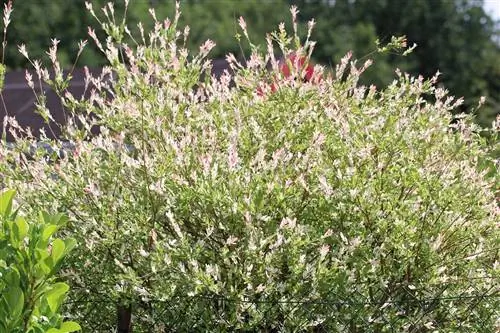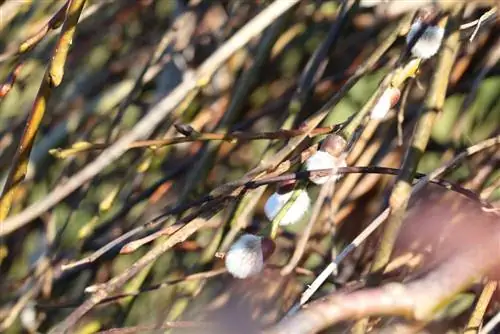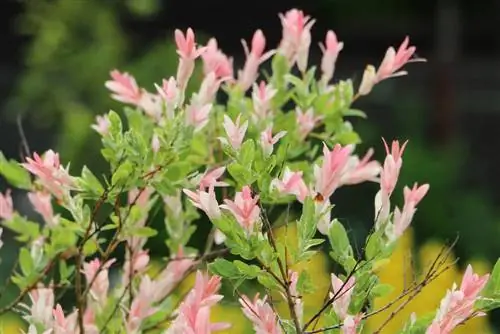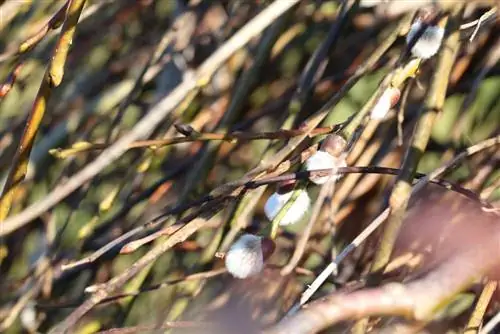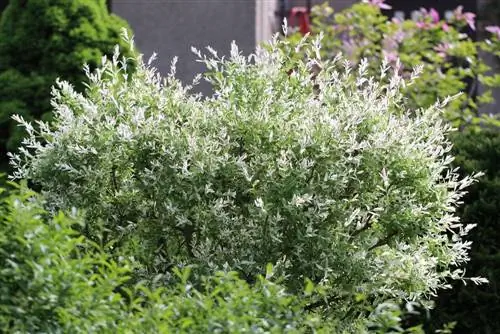- Author admin [email protected].
- Public 2023-12-17 03:39.
- Last modified 2025-01-24 12:45.
When it comes to care, the Salix integra 'Hakuro Nishiki' is quite easy to keep if you follow the following care tips. The shrub is relatively robust and can cope well with many different climatic changes. However, the shrub can also quickly die or stop growing if the wrong treatment is chosen. To ensure that this does not happen, you will now receive all the important elements for caring for the Salix integra 'Hakuro Nishiki'.
Location
The Salix integra feels particularly comfortable in sunny and partially shaded regions. This is where the growth is most pronounced. It can also survive in shady places, but it grows much more slowly there, and if constant care is not taken, it can even stop growing completely and even die. The color of the leaves makes it easy to see whether Salix integra needs more or less sun. Furthermore, the leaf color can be determined by the location. In partial shade they become lighter in color, in sunny places the leaves develop strong colors.
Floor
The soil plays a rather minor role for Salix integra. The soil has little influence on the plant; it can cope with many different types of soil. Soils interspersed with sand are particularly suitable. Here she feels particularly comfortable, becomes strong and growth progresses quickly. You should avoid soils that are very wet and heavily compacted. This is where the Salix integra has problems. Soils that the plant can easily cope with include
- clay soils
- Humus soils
- Clay soil only limited, drainage may be necessary
Seasons
The Salix integra is a frost-hardy plant and can survive outside in winter. If you keep it as a container plant, it can also be kept indoors in winter. This brings you small advantages when spring approaches again. Compared to a plant that has spent the winter outdoors, it has a head start in growing and flowering. Then the Salix integra begins its growth and flowering phase again, which then ends in late autumn. Basically:
- Autumn and spring best suited
- Planting possible all year round
- avoid frozen ground
Irrigation
The protective function of Salix integra helps with irrigation. If you are not sure whether you have watered enough, you just need to pay attention to the leaves and the growth. The leaves curl up and growth stunts if the plant receives too little water. Basically, it is important to ensure that you water them sufficiently, but not overwater them. The plant can survive on water for some time, but should not be neglected for too long. If this happens, you have the indicator of the protective function and can start watering straight away.
Transplanting/potting
When transplanting/potting, it is very important to pay attention to the plant's reaction. This can happen that the plant switches on its protective function. This could be a sign that roots have been injured. Minor root injuries are not a problem; the Salix integra should recover after a short time if the new conditions are good. The ideal time to repot the plant is late autumn. Here growth is slower and the plant has enough strength to get used to the new conditions.
Fertilization
Fertilizing Salix integra 'Hakuro Nishiki' is very easy. If it is kept as a container plant, occasional fertilization is completely sufficient. The best fertilizer for this is total fertilizer for willow trees. You should get this at your regular hardware store. If the plant is kept outdoors, you can add a little fertilizer to the water from time to time. The rule less is more also applies here and adding fertilizer is only necessary if the soil is poor in nutrients. If you want to add the fertilizer directly into the soil, you can do so in depot form.
Tip:
Regular fertilization additionally strengthens the plant and makes it more resistant to possible pest infestation. Furthermore, the growth process is accelerated.
Circumcision
Since Salix integra 'Hakuro Nishiki' is very fast-growing, regular cutting is very important. The ideal time for this is again late autumn, when the plant almost stops its growth efforts. But it can also be cut in spring. This should be done before the plant forms its first leaves, otherwise damage could occur. Furthermore, dead and rotten branches and leaves should be removed from the base trunk. This can also happen outside of the core seasons, as these only hinder the growth and he alth of the plant.
The shrub can also be trimmed more heavily when pruning. Approximately half can be cut off if you want to create the desired shape. However, you should also make sure that heavy cutting should only be done in autumn and not in spring. Excessive density of individual branches can also be thinned out. The highest priority when circumcising, regardless of the type and form, is that the base should not be damaged.
Propagation
As with all willow plants, the propagation of Salix integra 'Hakuro Nishiki' is extremely easy. All you need to do is cut off a branch and place it in a container with water. Adding fertilizer is not necessary. The branch should remain in the water until it takes root. Once the branch has grown enough roots, it can be planted in the desired location. Especially at the beginning, when a new branch has been planted, it needs sufficient watering. As the process progresses, watering can then be adjusted back to a normal level.
Planting time:
- Spring is ideal
- Summer also possible
- Late autumn rather unsuitable
Pests
This plant is also not safe from pests such as aphids, spider mites and other types of louse. Whiteflies and fungus gnats can also attack the plant, as can the fungal diseases powdery mildew, mildew, mold and rust. The best alternative to pest control is strengthening the plant itself. Good soil, location and regular fertilization help the plant grow strong and give pests and germs no chance. If the plant is still infected, chemical insecticides and fungicides can help against pests. You should also be able to get these from a standard hardware store.
Frequently asked questions
What colors do the leaves get?
The leaves are variegated white and pink when the location is optimal.
Can I plant Salix integra 'Hakuro Nishiki' outside outside of late autumn?
Yes, that is possible, but the ground should not be frozen. If it is planted in summer, ensure sufficient watering.
How fast does the plant grow?
They grow very quickly, sometimes over 50 cm per year, so that the maximum height is reached quickly and you should trim them often.
What you should know about Salix integra in brief
- The Salix integra is also called Japanese willow or harlequin willow and is usually grafted onto a standard tree.
- It is suitable for the front garden or as a container plant for the terrace.
- It has very beautiful white-green or pink speckled leaves that shimmer pink when they shoot.
- In spring, yellow catkins form, which are also very decorative. This plant looks best when it stands alone.
Cutting
In principle, only the crown of a Salix integra that has been grafted onto a standard tree grows, while the trunk maintains its height and only becomes slightly thicker. However, the crown grows up to 30 cm per year, so it should be cut back regularly. If you only want to reduce the size of the crown, a cut in early spring is sufficient, but if you want the crown to have a spherical shape, the shoots must also be shortened slightly in summer and autumn.
- During spring pruning, which is best done in the months of February and March, the branches can be shortened generously, because the Salix integra sprouts quickly again, so that the crown will soon be back to its old size.
- In summer and autumn, only the protruding shoots are cut off so that the crown takes on a round shape again. Over time it grows up to 1.20 meters high and just as wide; the trunk on which the Hakuro Nishiki was grafted must then be added to the total height of the tree.
- In the case of a grafted plant, shoots that form on the trunk should be removed as soon as possible, because these shoots only use unnecessary energy and do not belong to the Salix.
Care
- The Salix integra grows best in a sunny or at least bright location.
- It only needs a little water and can tolerate drought well.
- In the garden it usually doesn't need to be watered at all.
- With a potted plant, you should always wait until the top layer of soil has dried before watering.
- Plants in pots need some fertilizer because they cannot supply themselves with the necessary nutrients.
- If you have a Salix outdoors, you can do without fertilizer.
Wintering
No special protection is required even in winter, but for potted plants the pot should be wrapped with fleece or bubble wrap to protect the roots from the cold. Small feet or a Styrofoam plate on which the pot is placed help against the cold from the ground. However, when it comes to potted plants, you should not forget to water them in winter, but then even more sparingly than in summer.

